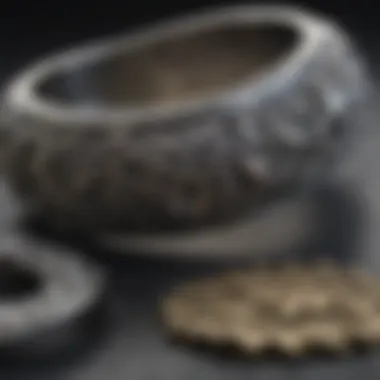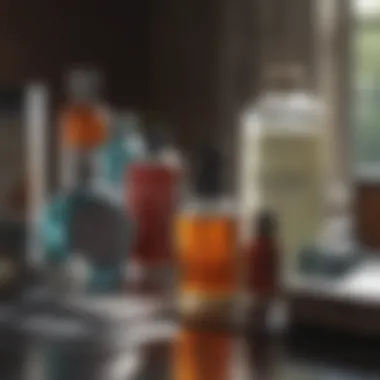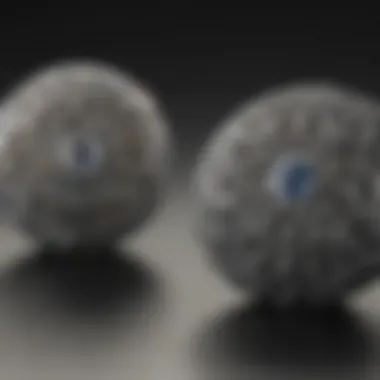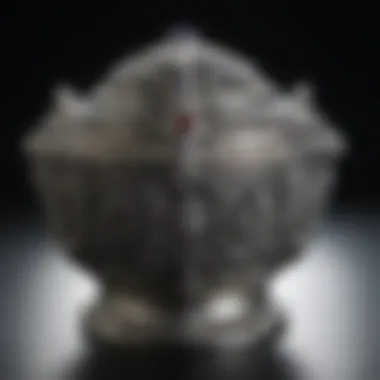Ultimate Guide to Cleaning Sterling Silver Items


Intro
Sterling silver is a cherished material, prominent for its elegance and versatility in jewelry and various decorative items. However, it is susceptible to tarnishing, which can detract from its luster. This guide focuses on essential techniques for cleaning and maintaining sterling silver, ensuring its beauty endures over time. By understanding the nature of tarnish, utilizing appropriate cleaning solutions, and implementing preventive measures, one can restore and retain the shine of sterling silver pieces.
In the following sections, we will explore the composition of sterling silver, the causes and characteristics of tarnish, effective cleaning methods, and practical tips for storage and care. Every item made from sterling silver can benefit from proper maintenance, which is why this comprehensive approach is invaluable for collectors, jewelry designers, and enthusiasts alike.
Understanding how to clean and cherish sterling silver not only enhances its appeal but also preserves its historical and sentimental value. Through this guide, readers will acquire knowledge and skills that elevate their appreciation of sterling silver, transforming it from mere ornamentation to an enduring legacy.
Understanding Sterling Silver
Understanding sterling silver is crucial for anyone who owns, collects, or designs items made from this metal. This section will explore the unique aspects and benefits of sterling silver, providing a foundational knowledge that will enhance your ability to care for and appreciate such items. Sterling silver's composition and characteristics make it a popular choice for jewelry and household items, contributing to its enduring appeal.
Composition and Characteristics
Sterling silver is an alloy primarily composed of 92.5% pure silver and 7.5% other metals, usually copper. This combination is necessary because pure silver is too soft and malleable for functional objects. The presence of copper increases its durability without significantly compromising the precious metal's luster. It’s essential to recognize that this alloy exhibits some distinctive properties:
- Tarnish Resistance: While sterling silver is prone to tarnishing, understanding its composition helps users anticipate care needs.
- Color and Finish: The bright, shiny appearance of sterling silver can be enhanced through various polishing techniques.
- Weight and Feel: Sterling silver items often feel more substantial than those made from lower-quality metals, which can add to their charm and perception of value.
Knowing these characteristics allows you to appreciate sterling silver beyond its aesthetic; it enables you to confidently select, clean, and maintain items crafted from this material.
Common Uses of Sterling Silver
Sterling silver serves numerous roles across different applications, confirming its versatility and popularity. The following are some of the primary uses of sterling silver:
- Jewelry: Rings, necklaces, bracelets, and earrings made from sterling silver are widely sought after for their beauty and strength.
- Tableware: Many people enjoy sterling silver utensils and serving dishes, which elevate any dining experience.
- Decorative Items: Candlesticks, picture frames, and vases are often crafted in sterling silver, adding elegance to interior design.
- Antique Collectibles: Vintage sterling silver items often attract collectors due to their historical value and craftsmanship.
In summary, recognizing the composition and use of sterling silver plays a vital role in understanding how to care for it properly. This knowledge will serve as the foundation for maintaining the beauty and longevity of your sterling silver treasures.
The Nature of Tarnish
Understanding tarnish is crucial for anyone who owns or cares for sterling silver items. Tarnish is not simply an unsightly blemish; it is a reflection of the chemical interactions that occur when sterling silver is exposed to the environment. By grasping the nature of tarnish, one can take appropriate measures to prevent and manage its formation, thereby preserving the integrity and beauty of their silver possessions.
What Causes Tarnish?
Tarnish forms when sterling silver reacts with sulfur-containing substances in the air or on the skin, creating a chemical compound known as silver sulfide. This reaction is unavoidable since silver is inherently reactive. Factors that accelerate tarnishing include humidity, exposure to certain foods, and contact with skin oils. Items like rubber bands or certain types of cloth can also contribute to tarnish formation.
In essence, tarnishing is a natural process that affects not only silver but also other metals. However, under the right conditions, such as a dry environment away from corrosive materials, tarnish can be minimized. Regular use of sterling silver items can also slow this process, as friction helps to maintain their shine.
Identifying Tarnish on Sterling Silver
Identifying tarnish on sterling silver is straightforward but requires careful observation. Tarnish often appears as a dull, gray, or black discoloration on the surface of the silver, which dulls its luster. In some cases, the tarnish can be uneven, creating a mottled look on the piece.
To effectively spot tarnish, one should look for:
- Color Changes: A shift from shiny to a dull or darkened surface.
- Surface Texture: Rougher areas that may appear uneven compared to the smooth parts.
When examining sterling silver, it is beneficial to shift the item in light. A well-lit environment helps to reveal tarnish that may not be immediately visible. Prompt action to clean tarnished items is advisable, as letting tarnish linger can lead to more stubborn build-up, which may require extensive cleaning methods to restore the silver's appearance.
"Regularly checking your silver items for tarnish can help maintain their beauty and prolong their lifespan."
Essential Cleaning Supplies
Cleaning sterling silver effectively requires the right tools and materials. The effectiveness of your cleaning efforts will largely depend on your choice of supplies. Choosing the right products not only makes the process easier but also preserves the integrity of the silver items. Skimping on quality often leads to poor outcomes and potential damage to the silver.
When selecting cleaning supplies, there are two main categories to consider: store-bought cleaners and homemade solutions. Both have their unique benefits and drawbacks. Understanding them is key to maintaining the shine and luster of your sterling silver without causing harm.


Store-Bought Cleaners
Store-bought cleaners are designed specifically for silver items. They are formulated to effectively remove tarnish and protect the shine of the silver. Brands like Hagerty and Wright's offer a range of products, including creams, sprays, and cloths.
These products generally provide immediate results and can be more effective in tough tarnish cases. However, it is important to follow the manufacturer's instructions carefully to avoid damage.
One downside is the potential for harsh chemicals that might affect the delicate nature of the silver over time. Therefore, always check the ingredient list and opt for reputable brands known for their silver cleaning products.
Homemade Cleaning Solutions
Homemade solutions offer a cost-effective and often gentler alternative for cleaning sterling silver. They utilize common household items to create effective cleaning mixtures. Below are three popular methods:
Simple Soap and Water
Using simple soap and water is one of the safest methods to clean sterling silver. This solution is gentle, so it won't harm the silver's finish. Typically, a soft, mild liquid soap combined with warm water is ideal for regular cleaning.
Key Characteristics:
- Non-abrasive: Prevents scratches.
- Readily available: Soap is a common household item.
Advantages:
- Ideal for routine maintenance.
- Safe for regular use.
Disadvantages:
- May not be effective for heavy tarnish.
Baking Soda Paste
Baking soda paste is a widely recognized method for tarnished silver. Mixing baking soda with a little water creates a paste that can gently polish silver.
Key Characteristics:
- Mild abrasive: Helps lift tarnish without deep scratching.
- Inexpensive: Baking soda is a low-cost household staple.
Advantages:
- Effective for removing tarnish, especially on flat surfaces.
- Environmentally friendly option.
Disadvantages:
- Requires some physical effort to apply and buff off the paste.
Vinegar and Baking Soda
Combining vinegar and baking soda results in a chemical reaction that makes a potent cleaning solution. This method is effective at removing tarnish with minimal effort.
Key Characteristics:
- Fizzing reaction: Helps lift tarnish deposits.
- Strong cleaner: Many users find it effective for stubborn tarnish.
Advantages:
- Quick and potent cleaning action.
- Utilizes common kitchen supplies.
Disadvantages:


- Should be used carefully, as the vigorous reaction can be messy.
- The strong reaction can potentially loosen settings in delicate pieces.
Using a combination of both approaches can maximize the effectiveness while minimizing damage. Consider the severity of tarnish and the specific characteristics of your silver items when choosing a cleaning method.
Step-by-Step Cleaning Methods
Cleaning sterling silver effectively requires knowledge and a systematic approach. A structured set of cleaning methods ensures that each piece maintains its beauty and integrity. This section will detail key procedures that cater to a variety of tarnish levels and item conditions. Consistency in cleaning can prevent further tarnishing and promote a lasting gleam for your silver items.
Basic Cleaning Procedure
The basic cleaning procedure is an excellent starting point for maintaining sterling silver. It is effective for light tarnish and everyday maintenance. The method involves using a soft cloth and mild soap. Begin by:
- Gathering Your Materials: A soft lint-free cloth, warm water, and a few drops of mild dish soap are all that is needed.
- Preparing the Solution: Mix warm water with soap in a bowl.
- Wiping the Surface: Dip the cloth in the soapy water, wring it out, and gently wipe the surface of the item.
- Rinsing: Use a separate cloth dampened with clean water to wipe away soap residue.
- Drying: Finally, dry with a different soft cloth to prevent water spots.
This process is quick and should be repeated periodically to avoid heavy tarnish build-up.
Deep Cleaning Techniques
When tarnish becomes more pronounced, a deep cleaning technique is necessary. This method also helps with intricate designs or patterns where tarnish is likely to hide. One effective technique involves:
- Creating a Baking Soda Paste: Mix baking soda with water to form a thick paste.
- Applying the Paste: Gently rub the paste over tarnished areas using a soft cloth or sponge.
- Rinsing Thoroughly: After cleaning, ensure to rinse the item well under warm water.
- Buffing Dry: Use a clean cloth to buff the cleaned item until it shines.
This method effectively removes tarnish without scratching the silver, ensuring its beauty is preserved.
Ultrasonic Cleaners
Ultrasonic cleaners offer an advanced method for cleaning sterling silver, particularly useful for delicate items. These devices use high-frequency sound waves to create microscopic bubbles in a cleaning solution, gently removing dirt and tarnish. Here are considerations for using ultrasonic cleaners:
- Choose Appropriate Solutions: Always use a cleaner that is safe for silver to avoid damage.
- Time Management: Follow the manufacturer's instructions regarding cleaning time. Overusing can cause harm to sensitive pieces.
- Inspect Before and After: Check the item closely post-cleaning to ensure no tarnish remains and no damage has occurred.
The use of an ultrasonic cleaner can save time and labor while achieving a high level of clean for your valued silver items.
"Consistent maintenance, followed by appropriate cleaning techniques, is vital to maintaining the aesthetic and structural integrity of your sterling silver."
Preventive Care for Sterling Silver
Preventive care is crucial for maintaining the aesthetic and value of sterling silver items. Regular care prevents tarnish buildup and helps preserve the bright, lustrous appearance that sterling silver is known for. By implementing some simple preventive measures, owners can reduce the need for extensive cleaning and ensure their silver pieces remain in optimal condition. This proactive approach can save time and effort in the long run, making it essential for anyone who values their sterling silver items.
Proper Storage Solutions
Storing sterling silver correctly is vital to prevent tarnish and damage. Here are some strategies to consider:
- Anti-Tarnish Cloths: Wrap silver items in anti-tarnish cloths. These cloths are treated with chemicals that inhibit tarnishing, providing a long-lasting solution.
- Individual Pouches: Opt for soft, breathable pouches for each item. This minimizes contact with other pieces that could cause scratches or damage.
- Avoid Plastic Bags: Do not use plastic bags, as they can trap moisture and lead to tarnish.
- Environment Control: Store silver in a climate-controlled environment. Humidity can accelerate tarnish formation, so aim for a cool, dry space.
Regular Maintenance Practices
Regular maintenance routines can further enhance the longevity and appearance of sterling silver. Here are key practices to adopt:
- Frequent Cleaning: Gently clean silver items every few months, even if they appear not tarnished. Use a mild soap solution and a soft cloth to avoid scratches.
- Rotational Use: If you have multiple silver items, rotate their use. Regular handling helps prevent tarnish, as oils from your skin can create a barrier.
- Polishing: Consider light polishing with a silver polish cloth to remove minor tarnish. This should be done sparingly to protect the finish.
- Avoid Chemicals: Keep sterling silver away from harsh chemicals. Household cleaners and certain cosmetics can cause tarnishing.
Remember: Maintaining sterling silver takes effort, but the reward is a stunning, shiny collection that can be enjoyed for generations.
Troubleshooting Common Issues
In the realm of sterling silver care, troubleshooting common issues is pivotal for maintaining the luster and quality of your pieces. Understanding potential challenges can prevent further damage and preserve the aesthetic and monetary value of your items. This section covers two significant problems that may arise: heavy tarnish and scratches or damage. By addressing these specific elements, one can ensure the longevity and allure of their sterling silver.


Dealing with Heavy Tarnish
Heavy tarnish can happen, especially if an item has not been cleaned or stored properly for a long time. It often appears as dark spots or a dull surface, detracting from the shine of your silver. To tackle this issue effectively, it is important to evaluate the severity of the tarnish before proceeding with any cleaning methods.
- Assessment: Identify how deep the tarnish is. Surface tarnish may be removed with basic cleaning solutions, while deeper tarnish might require more intensive cleaning.
- Choose the Right Method: Simple soap and water might suffice for lighter tarnish, but for more heavy tarnish, consider using a baking soda paste or professionally made metal polish designed for sterling silver.
- Application Process: Gently rub the silver with a soft cloth, applying cleaning solution only on tarnished areas. Avoid abrasive materials which can cause scratching.
- Rinse and Dry: Once the tarnish is removed, rinse the item under lukewarm water, then dry thoroughly with a soft cloth to prevent water spots.
"Heavy tarnish can significantly alter the appearance of silver but can often be remedied with proper cleaning techniques."
By promptly addressing tarnish accumulation, you ensure that your sterling silver retains its beauty and charm.
Avoiding Scratches and Damage
Protecting your sterling silver from scratches and damage is just as important as cleaning it. The beauty of silver can be marred by unintentional marks or scratches during handling or storage. Here are a few key considerations:
- Storage Solutions: When storing silver items, avoid placing them in direct contact with each other. Use soft cloths or felt pouches to separate pieces and prevent friction that could lead to scratches.
- Handling With Care: Always handle sterling silver with clean hands. Oils and dirt from hands can lead to staining and affect the finish. Additionally, avoid wearing rings or bracelets when cleaning silver to reduce the risk of unintentional scratches.
- Use of Proper Tools: When cleaning or polishing, utilize only soft, lint-free cloths. Avoid using paper towels or any rough materials that can result in scratches.
- Regular Inspection: Regular checks on your silver items can catch minor scratches early, which might be easily buffed out before they become more noticeable. Always maintain awareness of your pieces during regular use.
By adopting these precautions, you significantly lower the risk of inflicting damage and ensure your sterling silver remains a radiant part of your collection.
When to Seek Professional Help
Understanding when to involve a professional is crucial for maintainig sterling silver. Home remedies and straightforward cleaning techniques suit minor tarnish or maintenance. However, certain situations may warrant professional expertise. Engaging a professional service offers several benefits. These include access to specialized tools, knowledge on restoration techniques, and experience in handling unique items. The right approach can prolong the life of your silver items and restore their beauty.
Identifying Major Damage
Assessing whether your sterling silver needs professional attention depends on the extent of damage. Here are indicators:
- Extensive tarnish that remains after home cleaning: If tarnish persists despite various cleaning methods, a professional should assess your item.
- Visible scratches or dents: Damaged surfaces can benefit from specialized touch-ups that amateurs cannot effectively perform.
- Altered shape or missing pieces: For jewelry items or intricate designs, minor adjustments may require a jeweler's skill.
- Alloy issues or discoloration: Certain metal interactions are best addressed by experts who can determine the underlying cause and solution.
Once you recognize these signs, do not hesitate to seek professional help. Trying to fix such issues alone can lead to further damage.
Choosing a Professional Service
Selecting the proper professional service for your sterling silver requires careful consideration. Here are steps to ensure the right choice:
- Research specialists: Seek professionals who have experience specifically with sterling silver. Look for jewelers or restoration experts.
- Read reviews and testimonials: Online platforms like Yelp or specialty forums can provide insight from previous clients about their experiences.
- Ask for credentials: Ensure the professional has relevant certifications or training in silver restoration.
- Request quotes: Compare prices from different services. While cost shouldn't be the sole factor, it should align with the expected quality of work.
- Inquire about procedures: Understanding how a professional will approached your item will instil confidence. They should explain what they'll do, why, and potential outcomes.
Each of these steps enhances your certainty and assures you of receiving suitable care for your sterling silver pieces.
Final Thoughts
Cleaning and maintaining sterling silver is not merely about aesthetics; it is essential for preserving the quality and longevity of your cherished items. As this article discussed, tarnish is a natural process that occurs when sterling silver is exposed to oxygen and sulfur in the environment. Understanding this phenomenon enriches your approach to taking care of silver, making it imperative to integrate consistent cleaning practices into your routine.
Maintaining the beauty of sterling silver is tied to how well you understand its intricacies. Engaging with the various cleaning techniques, whether homemade or commercially available, highlights the flexibility one has in caring for these items. The emphasis on preventive measures, such as proper storage and regular maintenance, ensures that your silver retains its luster over time.
Moreover, knowing when to seek professional help can save you from irreversible damage and offers peace of mind. With all these considerations, it becomes evident that diligent attention to sterling silver care not only enhances its visual appeal but also preserves its intrinsic value.
Maintaining the Beauty of Sterling Silver
A systematic approach to maintaining the beauty of sterling silver encompasses several key elements. Regular cleaning is a fundamental practice. Utilizing gentle methods, such as a soft cloth or mild soap, prevents scratches that can mar the surface. For items that are used frequently, it is advisable to make cleaning a routine to combat tarnish before it becomes more severe.
One effective strategy involves using silver polish, which can be found in various forms. Apply it with a soft cloth, following the manufacturer's instructions for optimal results. Additionally, consider investing in anti-tarnish storage solutions, like treated cloths or boxes that specifically resist tarnishing.
Keep in mind the impact of environmental factors. Humidity, exposure to air, and interactions with other materials can contribute to tarnish formation. Therefore, taking steps to maintain a consistent environment for your silver items is beneficial.
"Regular maintenance helps avoid heavy tarnish and ensures your silver remains elegant and valuable."
Embracing the Patina
Embracing the patina of sterling silver is about acknowledging the unique character that develops over time. As silver ages, it acquires a distinctive hue that many collectors and enthusiasts find appealing. This natural patina can enhance the historical beauty of an item, reflecting its journey and personal stories.
Some prefer to retain this patina, as it offers an authentic touch to heirlooms and antiques. It is essential to understand that while many cleaning methods aim to remove tarnish, preserving a light patina can be desirable for specific pieces. This is especially true for items that are intended for display rather than everyday use.
Consider balancing the cleaning process with the desire to keep the patina intact. Using softer cleaning techniques, or allowing small amounts of tarnish can create a sense of depth and richness that adds character to your sterling silver. Finally, knowing when to appreciate the patina as part of a piece's story makes silver care both practical and personal.







